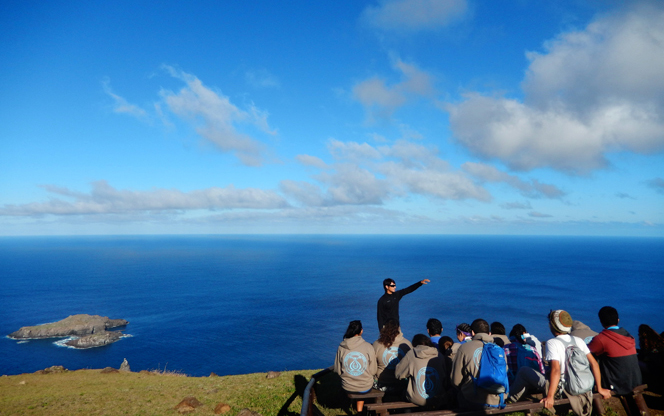Archaeology and engineering point in different directions for students on an isolated, misunderstood island in the southeastern Pacific, but a summer program featuring both disciplines is bringing them closer to their cultural roots while opening a future of personal growth and environmental sustainability.
Under the guidance of a team assembled by Northern Arizona University’s Britton Shepardson, a group of high school students on Easter Island spent part of their summer designing a bicycle-powered generator, building wind turbines and even developing a desalination demonstration project.

The engineering track—specifically, renewable energies—was added this year to Shepardson’s long-running work through Terevaka, a non-profit educational outreach program he established after his own intensive research on the island as an archaeologist.
Seeing the need for young people on the island to connect with and preserve their Rapanui heritage, Shepardson chose more than a decade ago to intervene through a hands-on summer program. But on an island challenged for natural resources and feeling the pressure of tourism and modernization, it became clear that more needed to be done.
“I’ve seen a shift over the years on the island,” Shepardson said. “Students are not only becoming more interested in local archaeology, history and culture, but they are also more aware of conservation and environmentalism.”
In response, Shepardson turned to his own recent interaction with the Wind for Schools program at NAU. Engineering graduate student Marilla Lamb adapted the program’s curriculum to fit Terevaka’s two-week summer workshop and the specific needs on Easter Island.
“Her first draft was right on the spot,” Shepardson said. “It’s experiential learning that I knew these kids would get into. Wind power, solar power and desalination are all pressing issues on the island.”
The team grew to include Shepardson’s brother, Dylan, a mathematics professor at Mt. Holyoke College; Matt Petney, an NAU alum who also helped with curriculum development; NAU undergraduate anthropology interns Madison Ledesma and Sara Sanford; and two undergraduate interns from Mt. Holyoke. Each of them spent at least some time on the island during the month-long project. Besides curriculum, Wind for Schools donated wind turbine kits.
Once the summer program was under way, 14 island high school students camped together and went on educational field trips with the interns and Shepardson. During breakout sessions, the archaeology group endeavored to match place names from the island’s oral tradition to the actual sites, while the engineering group worked on turbine and generator projects.
Their work was presented to the community in an “uncharacteristically fancy and formal” ceremony, Shepardson said. About 80 people attended, representing 1 percent of the island’s total population.
“It was the most incredible experience to see students perform when the pressure was on,” Shepardson said. “They not only showed they had created a bike generator but they improvised knowledge of alternating current. Their parents were crying at the end.”
Students also demonstrated the generator operating a blender to staff at the Explora Hotel—a strong supporter of Terevaka—and the desalination demonstration was operated for staff in the hotel’s kitchen.
“The students even used scrap materials from a recycling yard to assemble a wind turbine that would have worked, in theory,” Shepardson said. “They had only two blades and needed more.”
Shepardson’s long-term hope is that knowledge contributed by the students to a publicly accessible database will help preserve not just archaeological information, but also the students’ ties to a fast-fading culture with origins deep in the island’s mystique. And he hopes they will be more prepared to contribute to a sustainable future on the island while building their own careers.
“The idea is to inspire kids for what to study if they go on to universities in Santiago (in Chile) or elsewhere,” Shepardson said. “It gives them a taste of higher education geared specifically to issues on the island and in their community.”



